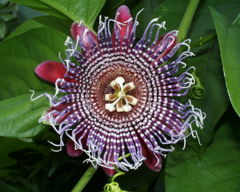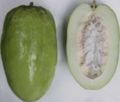Giant granadilla: Difference between revisions
template |
No edit summary |
||
| Line 29: | Line 29: | ||
| cultivar = | | cultivar = | ||
}} | }} | ||
{{ | {{Inc| | ||
Passiflora quadrangularis, Linn. Granadilla. Fig. 2770. Tall | |||
strong climber, glabrous: lvs. ovate or round-ovate,cordate at base, | |||
mu- cronate, entire, the petiole with 2 or 3 pairs of glands: | |||
stipules large: fl. large (3-5 in. across) and interesting, fragrant | |||
with ovate sepals and petals (the former white within and the latter | |||
reddish), the crown composed of 5 series of white-and-purple | |||
particolored filaments, of which the outermost exceed the floral | |||
envelopes: fr. oblong, 5-9 in. long, yellowish green, pulpy and | |||
edible. Trop. Amer. B.R. 14. R.H. 1898, p. 569. Gn. 51, p. 313; 59, | |||
pp. 4, 7. G. 33:161 — Widely grown in the tropics, and variable, both | |||
as a vine and for its edible frs. Frequent in collections of economic | |||
plants in the N. It is a good climber for covering a greenhouse roof. | |||
Best results are secured if the temperature does not fall below 50°. | |||
The fr. ripens in summer. The fls. usually need to be hand-pollinated | |||
if fr. is wanted on house-grown plants. Var. variegata, Hort. (P. | |||
variegata, Hort. P. aucubifolia, Hort.), has foliage blotched with | |||
yellow. | |||
}} | |||
''Passiflora quadrangularis'', is the largest of the passionfruits. | ''Passiflora quadrangularis'', is the largest of the passionfruits. | ||
Latest revision as of 05:48, 23 June 2009
Passiflora quadrangularis {{{latin_name}}}
|
Giant granadilla, Badea
| ||||||||||||||||||||||||||||||||||||||||
|---|---|---|---|---|---|---|---|---|---|---|---|---|---|---|---|---|---|---|---|---|---|---|---|---|---|---|---|---|---|---|---|---|---|---|---|---|---|---|---|---|---|

|
|
| |||||||||||||||||||||||||||||||||||||||
| |||||||||||||||||||||||||||||||||||||||||
| Standard Cyclopedia of Horticulture |
|---|
|
Passiflora quadrangularis, Linn. Granadilla. Fig. 2770. Tall strong climber, glabrous: lvs. ovate or round-ovate,cordate at base, mu- cronate, entire, the petiole with 2 or 3 pairs of glands: stipules large: fl. large (3-5 in. across) and interesting, fragrant with ovate sepals and petals (the former white within and the latter reddish), the crown composed of 5 series of white-and-purple particolored filaments, of which the outermost exceed the floral envelopes: fr. oblong, 5-9 in. long, yellowish green, pulpy and edible. Trop. Amer. B.R. 14. R.H. 1898, p. 569. Gn. 51, p. 313; 59, pp. 4, 7. G. 33:161 — Widely grown in the tropics, and variable, both as a vine and for its edible frs. Frequent in collections of economic plants in the N. It is a good climber for covering a greenhouse roof. Best results are secured if the temperature does not fall below 50°. The fr. ripens in summer. The fls. usually need to be hand-pollinated if fr. is wanted on house-grown plants. Var. variegata, Hort. (P. variegata, Hort. P. aucubifolia, Hort.), has foliage blotched with yellow.
|
Passiflora quadrangularis, is the largest of the passionfruits.
- More information about this species can be found on the genus page.
Cultivation
| calendar? | ||
|---|---|---|
| January: | ||
| February: | ||
| March: | ||
| April: | ||
| May: | ||
| June: | ||
| July: | ||
| August: | ||
| September: | ||
| October: | ||
| November: | ||
| December: | ||
| Notes: | ||
- Do you have cultivation info on this plant? Edit this section!
Propagation
- Do you have propagation info on this plant? Edit this section!
Pests and diseases
- Do you have pest and disease info on this plant? Edit this section!
Cultivars
Gallery
If you have a photo of this plant, please upload it! Plus, there may be other photos available for you to add.
References
External links
- w:Giant granadilla. Some of the material on this page may be from Wikipedia, under the Creative Commons license.
- Giant granadilla QR Code (Size 50, 100, 200, 500)


